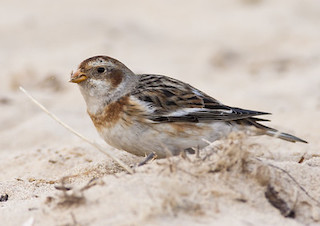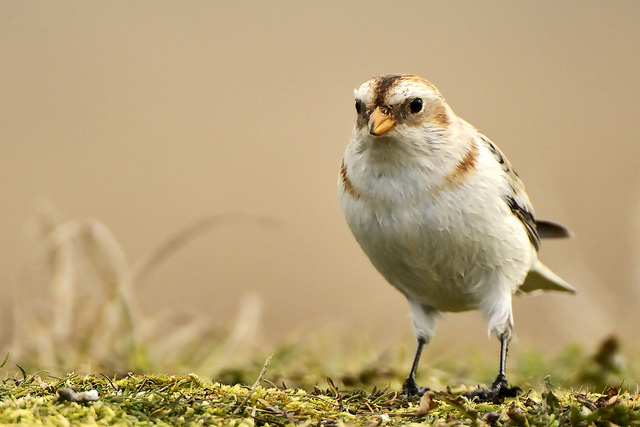 A breath of Arctic air – Snow Buntings can be spotted on migration at Lizard Point.
A breath of Arctic air – Snow Buntings can be spotted on migration at Lizard Point.
Photo: © Natural England/Allan Drewitt
Scientific name: Plectrophenax nivalis
Other common names: Snowflake
Conservation status: UK Birds of Conservation Concern, Amber; IUCN Red List, Least Concern.
What to look for:
- Colouring and appearance: Male summer breeding plumage consists of a snowy white chest, belly and head with contrasting black wingtips and upper parts, with females being more mottled on their back. The autumn/winter plumage is sandier and generally more mottled. The black-tipped yellow bill is all black in males in summer.
- Size: Length 16 cm, wingspan 35 cm.
- Where: Cairngorms in summer, northern coastlines in winter with smaller numbers further south.
- Call: Chirruping short bursts of song.
- Similar species: Lapland Bunting
 The Snow Bunting brings a little bit of the Arctic to the UK. This bunting is a remarkably tough High Arctic specialist, breeding far to the north on the tundra of its circumpolar breeding range. It is the most northerly breeding songbird on the planet. The Cairngorms region in Scotland also boasts a small breeding population; otherwise, you are most likely to spot Snow Buntings when they visit our shores in the winter, or as they pass by on migration in the autumn and spring. They often form flocks, swirling in the air like snowflakes.
The Snow Bunting brings a little bit of the Arctic to the UK. This bunting is a remarkably tough High Arctic specialist, breeding far to the north on the tundra of its circumpolar breeding range. It is the most northerly breeding songbird on the planet. The Cairngorms region in Scotland also boasts a small breeding population; otherwise, you are most likely to spot Snow Buntings when they visit our shores in the winter, or as they pass by on migration in the autumn and spring. They often form flocks, swirling in the air like snowflakes.
Male Snow Buntings are the first birds to return to the Arctic in the spring, arriving from mid-March to establish their territories. The females follow four to six weeks later and, after pairing, build the cup-shaped, moss-lined nests in June, placed in rock cavities or cracks. Each female lays between two and eight eggs; the male helps feed the female while she incubates the clutch. Both parents feed all the chicks until they leave the nest but, after that, the chicks are divided into two groups, with each adult taking sole care of one of the two groups, until the young birds can look after themselves (usually up to twelve days after leaving the nest). Snow Buntings eat seeds and invertebrates, with the latter being the main food source for the chicks.
In winter, Snow Buntings head south, but not that far, migrating to regions including southern Canada, Alaska and Scandinavia. In the UK you are most likely to see them further north round the shoreline, but a small number make it as far as the southwest.
Did you know…?
…Most birds change from their winter to summer plumage by moulting, but not the male Snow Bunting. The buff-coloured tips of the winter feathers wear away in the late winter, exposing the black and white-coloured feather bases beneath.
…Three bird species have been seen at the north pole: the Fulmar, the Kittiwake, and the Snow Bunting.

More information and references:
Svensson, L., Mullarney, K., Zetterstrom, D.,1986. Collins Bird Guide, second edition (translated by Christie, D., Svensson, L.). HarperCollins, London.
Published: October 2015
Author: Amanda Scott
Photos: Upper: © Natural England/Allan Drewitt; lower: © Natural England/Julian Dowse
